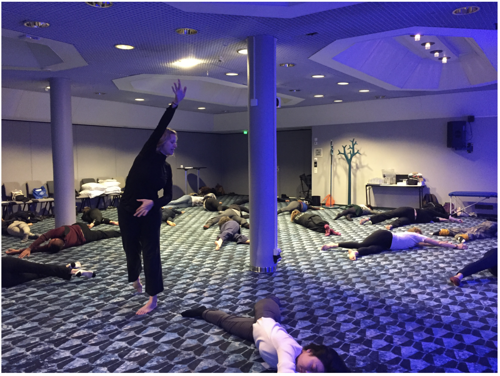Helsinki in Retrospect: Movement Session/Partner-Based Bodymind Warm-up
Author: Meredith Lyons on behalf of the Dance Educators’ Committee
In preparation for #IADMS2019 in Montreal I was excited to reflect on a presentation I did with Betsy Miller last year in Helsinki at #IADMS2018. Movement sessions provide an important venue for hands-on application of research and group feedback.

Betsy Miller and I presented on how somatics has become commonplace in dance academia curricula. We discussed the importance of somatic movement patterns in connection to improvisation and partner work in undergraduate, graduate and professional dance studies. However, even as collaborators, Miller and I came to the conclusion that we have differing viewpoints on how to approach and teach these fundamentals. As we unpacked our movement histories and dance lineage of educators and choreographers, we found that the common landing place for us was the importance of somatic based partnership, which is what we taught in Helsinki.
When looking at Thomas Hanna’s definition of somatics ‘the art and science of the inter-relational process between awareness, biological function and the environment, with all three factors understood as a synergistic whole’ (Fitt 1996: 303), questions formed on how to incorporate all three factors: What exercises help bring attention to both body and mind in relation to our individual selves and partner(s)? What are some key exercises/movement patterns to warm up our individual selves, while staying in tune to the partner(s) in space? Is physical touch essential in warming up the body to partnership? How does improvisation play a role? How can imagery be used within set movement material and improvised movement to prepare for partnership in dance? What are essential building blocks in the teaching of dance somatics? What are important takeaways? Is this even possible for participants in a conference setting, with limited time, and resources? As we distilled our thoughts we came to the conclusion that not only is somatics an important factor in improvisation and partner work, but the body and mind have a complicated and complex dualistic relationship. The purpose of the session was to provide participants with a framework and specific exercises to integrate somatics and partnering skills into a contemporary dance technique class, while promoting effective, healthy and mindful approaches to training and treating dancers.

We first started the movement session by guiding participants in a floor based individual warm-up that combined elements of somatic principles such as Bartenieff Fundamentals, Feldenkreis, and Skinner release technique and that included imagery and experiential anatomy (these somatic techniques are commonly used in the modern dance classroom and are described at the end of this post). This later moved into physical touch in a partner-based warm-up that incorporated initiation with minimal weight sharing that could later be used for contemporary/modern dance classes. Throughout the movement sessions participants engaged in somatic exercises as either a mover or facilitator to explore possibilities for movement initiation, pathways, effort, weight, and mind/body integration. Throughout the workshop, Miller and I shared both set material and guided improvisation scores that were designed to enhance bodily awareness, mindfulness, specificity and efficiency, as well as prepare dancers for potential rigorous contemporary phrase work. The movement pathway of the session started from the floor, that led to the bodies moving up through and across the space. These movement pathways executed a wide range of partnering with both contact and non-verbal initiation, that allowed for individual improvisation within the duet. Somatic approaches such as Bartenieff Fundamentals, Feldenkreis, and Skinner release technique placed focus on releasing soft tissue while teaching the body to move freely without restrictions, instilling dynamic play and precision. The reported benefits ranged widely from improved range of motion, strength and alignment, to neuromuscular efficiency. Dancers stand to benefit holistically from cultivating an approach to movement that integrated body and mind experience. The movement session highlighted the relationship between initiation, pathways, effort, weight, and body-mind integration, with reference to execution in a wide range of contemporary dance techniques and partnering. Participants moved freely with one another, at moments finding autonomy while also bridging connections across the room. It was wonderful to witness the diversity of movement in space, exchange in the room, and the care given to not only their individual selves but to one another.
As I think back to the conference and our movement session, I keep coming back to the reference point that somatics is at the heart and soul of what we do as movers in contemporary dance practice. As a presenter I gained insight and feedback on how to continue to apply this movement session to students in higher education and the general public. What I found amazing was how open, willing and excited participants were to share in the dynamic play of partnership. The amount of risk they took within their own embodied logic, and in partnership, was such a joy to witness. It was a wonderful reminder that the continual practice of focusing on the inner locus of control incorporates not only the body, but the mind and spirit. It is what moves us as dancers and in partner work and helps us share the dance that we love and the dance that we seek.
---------------------------------------------------------------------------
Meredith Lyons, MFA, Full Apparatus Certified Pilates Instructor
2019 Performing Arts Peace Corps Response Volunteer, Dominica
Assistant Professor of Dance, Colorado Mesa University
Dance educator, scholar, Pilates instructor. Dance Pedagogy research informed by studies of Ballet, Modern, Jazz, Pilates, Yoga, Improvisation, Administration, Dance History, Choreography, Body Mind Centering, Experiential Anatomy, Kinesiology and Nutrition for Dancers.
Betsy Miller, MFA, Assistant Professor of Dance, Salem State University
Dance artist, scholar and educator.
Pedagogical approach informed by studies of somatic modalities including yoga, Body Mind Centering, Spiraldynamik, Bartenieff Fundamentals and experiential anatomy.
www.betsymillerdanceprojects.com
Resources
A. Olsen. The Place of Dance: A Somatic Guide to Dancing and Dance Making. Wesleyan University Press; 2014.
Geber P, Wilson M. Teaching at the interface of dance science and somatics. Journal of Dance Medicine and Science. 2010;14(2):50–57.
Fortin S, Vieira A, Tremblay M. The experience of discourses in dance and somatics. Journal of Dance and Somatic Practices. 2009;1(1):47–64.
Batson G, Schwartz RE. Revisiting the value of somatic education in dance training through an inquiry into practice schedules. Journal of Dance Education. 2007;7(2):47–56.
Eddy M. Dance and somatic inquiry in studios and community dance programs. Journal of Dance Education. 2002;2(4):119–127
Fitt SS. Dance Kinesiology. 2. New York: Schirmer Books; 1996.
Useful Descriptions